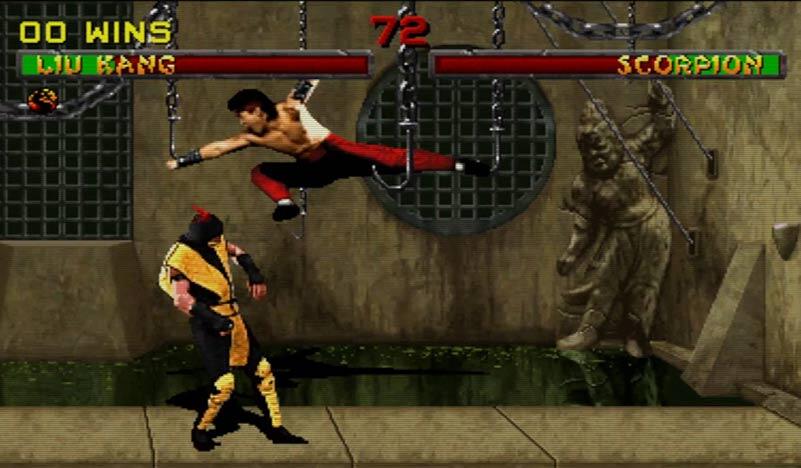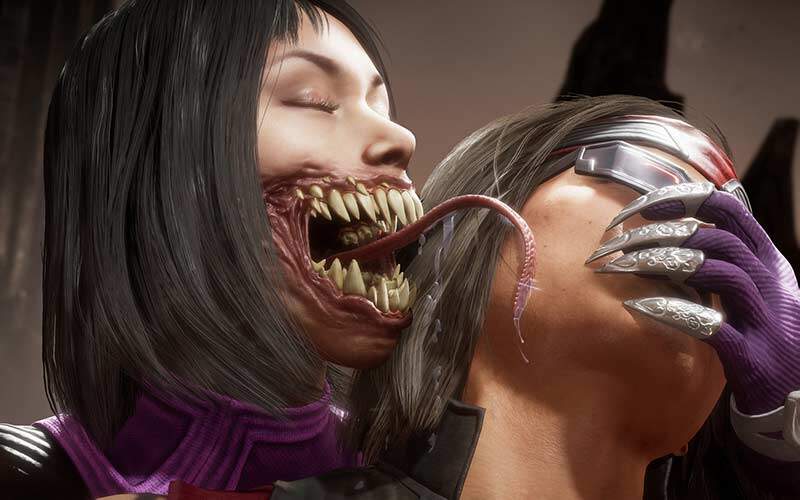In 1992 a fighting game, centred around the titular Mortal Kombat tournament shattered screens worldwide and changed the way the genre was viewed forever. After ten direct sequels and a horde of spin offs the series is still painting our screens with blood and viscera to this day, most notably with its latest instalment, MK11 (2019), where the grisly Fatalities and Brutalities (that contributed to the founding of the ESRB) are as ever prominent. It was almost reactionary in hindsight, taking the idea of a fighting game from martial arts action to a far more demonic, low-brow and downright nasty horror dimension.
The idea seems to have been born from some nightmarish dream combining Enter The Dragon (1973) with the savagery of grindhouse cinema. As a child it felt like a forbidden series (MK:Trilogy (1996) being the first I played), one that allowed the inflicting of violence and hatred that I never thought possible at such a young age. They were only sprites, tiny pictures of people, though the brutality between them genuinely shocked me.

We weren’t just fighting here, we were looking to decimate one another, and the idea of finding new and even more complex and disgusting methods of doing so was enough to glue me to the series to this day. Over the top, execution-style fatalities seemed more like torture than fighting and the unnecessary overkill factor had a merciless feel rendering it authentically scary. Using meathooks, machetes and more, the characters of Mortal Kombat pull off such imaginative slaughter that the influence from such slashers as The Texas Chainsaw Massacre (1974) and Friday 13th (1980) are impossible to ignore.
Taking place in an alternate dimension of gruesome savagery and merciless, unparalleled punishment, the series invokes horrors similar to a lot of real-world mythologies. Reflecting this is a roster of characters ranging from sinister warriors protecting hellish realms, gods that crush craniums with their minds, a spectral ninja with a flaming skull, and a reptilian henchman wearing a disguise of human skin. Properly considered, every pore of the franchise seeps horror. It could even be said that MK deals more and more in cosmic horror with its inclusion of ‘Elder Gods’ and a rather Lovecraftian universal origin story involving ‘The One Being’.

Mortal Kombat has always been a theatre of hideous monsters. Classic characters such as Baraka and Mileena, with their unreasonably large fangs, are born of inbreeding between demons and the citizens of Outworld; while more recent abominations include the insectile D’vorah, who spews swarms of insects and has a penchant for impaling opponents with her terrifying arachnid arms.
Mk’s horror influences are not entirely limited to slasher and monster movies either; Dark magic permeates the universe, with many fighters demonstrating occult practices. Quan Chi favours necromancy to meet his nefarious needs, while Ermac and Shang Tsung depend on tortured souls to fuel their power. These along with demons, terrifying warrior emperors and brutal multi-dimensional assassins mean the depth and depravity of Mortal Kombat’s character lore knows no limit.
Of course, a roster of savage fighters would be nothing without suitably horrifying places to fight. A good amount of MK’s arenas commonly involve floating spectral skulls, hanging corpses, unsettling faces watching from within sinister trees and lingering darknesses. Mortal Kombat’s arenas are some of the best in fighting game history, and the inclusion of interactive environments has arguably made them all the stronger. From Shang Tsung’s famous courtyard to The Pit, a precarious bridge over a dizzying drop into spike pits below, no fighter is safe from these death traps. Arguably the most gruesome of these is the Dead Pool, an underground dungeon of pure nightmares involving a reservoir of acid ready to consume the next unfortunate loser.
Mortal Kombat knows exactly what it is, knows its audience and knows why it has had such a widespread appeal over the years. In this knowledge it has taken no effort in distancing itself from the horror scene, involving many of our favorite horror icons as playable characters such as Leatherface, the Xenomorph, Predator, Jason Voorhees, and Freddy Kreuger. It seems that characters must spill a considerable amount of blood before they can get into the kombat klub. Mortal Kombat is as close as we’re bound to get to an actual horror-themed fighting game and in this kombatant’s humble opinion, it’ll do nicely.
Article originally posted on Beyond the Veil
Joe first knew he wanted to write in year six after plaguing his teacher’s dreams with a harrowing story of World War prisoners and an insidious ‘book of the dead’. Clearly infatuated with horror, and wearing his influences on his sleeve, he dabbled in some smaller pieces before starting work on his condensed sci-fi epic, System Reset in 2013.Once this was published he began work on many smaller horror stories and poems in bid to harness and connect with his own fears and passions and build on his craft.
Joe is obsessed with atmosphere and aesthetic, big concepts and even bigger senses of scale, feeding on cosmic horror of the deep sea and vastness of space and the emotions these can invoke. His main fixes within the dark arts include horror films, extreme metal music and the bleakest of poetry and science fiction literature.
He holds a deep respect for plot, creative flow and the context of art, and hopes to forge deeper connections between them around filmmakers dabbling in the dark and macabre.


